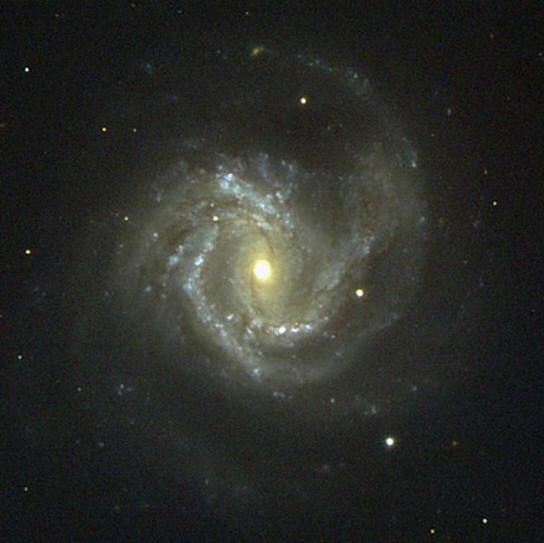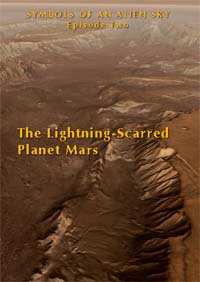|

Galaxy M61 displays hexagonal
interlacing. Credit: Hillary Mathis,
N.A.Sharp/NOAO/AURA/NSF
Galactic Hexagon
Mar 10, 2011
Some galaxies exhibit
polygonal structures.
The term "diocotron instability"
is not generally well known. Its use
is confined to the field of plasma
physics and refers to the
distortions that occur when two
sheets of plasma flow past each
other. It is often confused with the
Kelvin-Helmholtz instability seen in
dynamical fluid interactions.
Since plasma is a charged
substance, with a small percentage
of its particles being ionized, it
does not tend to obey the laws of
kinetic motion. Rather, plasma is
more strongly influenced by
electromagnetism than it is by any
other force, including gravity.
A principle of physics underlying
all aspects of Electric Universe
theory is that plasma makes up
99.99% of the Universe. From
lightning, to
auroral curtains, to the
solar wind, to the interstellar
medium, to stars, to the galactic
glow permeating space, everything is
plasma. As such, it is expected that
what can be observed is going to be
a manifestation of forces acting on
electrically charged material, no
matter how tenuous.
When unusual characteristics are
observed, no matter what scale, the
fact of plasma's behavior should be
given first priority in any attempt
to resolve the question. In the
image at the top of the page, a
bizarre hexagonal formation can be
seen in the arms of galaxy M61 (NGC
4303). There is little in the
astronomical lexicon that can
explain the bent, interlaced arms of
what should be a smooth spiral.
Astronomers have no requirement
for training in electric theory.
Maxwell's equations might as well be
classical Greek poetry to most
astronomers. They have far too much
to do without getting involved in
topics that are irrelevant to their
work. Gravity is the foundation for
the majority of scientific thought
about the cosmos, so electrodynamic
formulae are rarely consulted, if at
all.
Many natural structures have been
shown to be hexagonal: Saturn's
hexagon, hexagonal craters on
planets and moons, and hurricane
eyes, to name a few. Despite one
astronomer's contention
that fluid dynamics is all that is
needed to explain Saturn's hexagon,
it is not possible to use that
explanation for the other phenomena,
as well. Besides, there are other
occurrences on Saturn that are
clearly electrical in nature: the
ring spokes, the Dragon Storm, the
Great White Spot, the polar aurorae,
and the mid-latitude ultraviolet
discharges.
A diocotron instability explains
the Saturnian hexagon quite well.
Plasma's characteristic behavior
also explains the other Saturnian
events. Can the same explanation
appertain to
galaxies?
Electric Universe theory
considers galaxies to be the progeny
of electromagnetic coupling.
Birkeland current filaments conduct
electricity across cosmic distances,
twining around one another until
they crush plasma into discrete
formations. A typical barred spiral
galaxy is created in two or more
twists of those intergalactic
filaments.
Diocotron instabilities in the
Birkeland current filaments are most
likely responsible for the hexagonal
shapes seen in galaxies. Electric
power can act with trillions of
times more force than gravity. When
a plasma Universe is considered, the
mysteries left by gravitational
theories are resolved.
Stephen Smith
Hat tip to Lloyd Kinder
Multimedia

The Lightning-Scarred Planet Mars
Symbols of an Alien Sky
DVD episode 2
A video documentary that could change everything you thought you knew
about ancient times and symbols.
The Symbols of an Alien Sky video series will introduce you to celestial
spectacles and earth-shaking events once remembered around the world.
Archaic symbols of these events still surround us, some as icons of the
world’s great religions, though the origins of the symbols appear to be
lost in
obscurity.
In this second episode of Symbols of an Alien Sky, David
Talbott takes the viewer on an odyssey across the surface of Mars.
Exploring feature after feature of the planet, he finds that only
electric arcs could produce the observed patterns. The high resolution
images reveal massive channels and gouges, great mounds, and crater
chains, none finding an explanation in traditional geology, but all
matching the scars from electric discharge experiments in the
laboratory.
(Approximately 85 minutes) See:
Lightning-Scarred
Planet info
|








